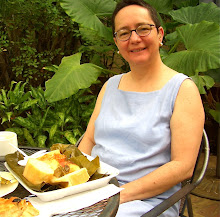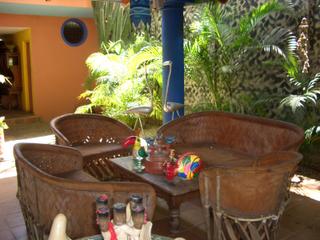
More than 40 years ago, a Nicaraguan monk and poet, who had studied under Thomas Merton in a Trappist monastery, came to the islands of Solentiname. This man, Padre Ernesto Cardenal, founded a spiritual retreat and began working with the struggling local population. Through his inspiration, the islanders experimented with painting and drawing. Padre Ernesto supplied them with their first paints and supplies, and brought a famous artist from Managua, Roger Perez de la Rocha, to teach painting techniques.

While Padre Ernesto provided the initial inspiration for the economic improvements in the lives of the people of Solentiname through the arts, he also provided a powerful spiritual environment for contemplation and conversation. The merging of the spiritual, artistic and political came naturally through continuing dialogue between Padre Ernesto and the campesino's of the Islands.

These conversations developed into a spiritual philosophy based on Christian
liberation theology and principles of social justice and community sharing. The remarkable philosophy has had widespread influence in the political and social life of Nicaragua, especially when Padre Ernesto became the first Nicaraguan Minister of Culture under the Sandinista government which came to power in the 1980's.

Over 1000 campesinos participated in these dialogues about social equality, and analyzing their economic and living conditions. Eventually, a beautiful book was created from these conversations, The Gospel According to Solentiname, which considered how their Savior would have lived his life in contemporary Nicaragua.
Below is a description by Padre Ernesto of the evolution of the conversations and the eventual development of the paintings in the book.

The Gospel According to Solentiname
by Ernesto Cardenal
Every Sunday, on the Island of Solentiname, a withdrawn oasis on Nicaragua Lake, we hold a discussion with campesinos instead of a sermon on the Gospel. The campesinos’ comments are usually more incisive than those of many theologians, but as guileless as the Gospel itself. This is not odd: the Gospel, or "good news" was written for and by people similar to them.
Some friends advised me not to let these commentaries fade away, but to collect and publish them in a book. This is that book. I first began collecting them by memory and went back as far as possible. Then, in a more pragmatic sense, we used a tape recorder.
Many of these interpretations were offered at church, at Sunday mass - also, in the straw hut, where we held our meetings and our community lunch after mass. We often held our mass and discussion of the Gospel here under the open sky, at other islands, or at a small hamlet by a beautiful river with lush, tropical vegetation.
Every Sunday, we give each attendee a copy of the Gospel. That is, those who can read. We have a few who cannot read - mainly the elders. That’s because they come from islands far from the school. Someone who reads better, usually a younger boy or girl, reads us the chapter that is to be studied. Then, we offer our commentaries line by line.
Thirty-eight islands make up the Solentiname archipelago - some are quite small and only the larger islands are inhabited. There are about a thousand people living there. That makes around ninety families. Homes are typically straw huts that are scattered, one far from the other, on these islands’ beaches. Our community or laity monastery, Our Lady of Solentiname, is situated on the tip of the biggest island. The Colombian poet, William Agudelo, his wife, Teresita, and their two small children, Irene and Juan are part of this community. Also, three youngsters were born on these islands, Alejandro, Elbis and Laureano. Communication with the outside world is not frequent and our meditation is not disturbed in this place. It’s not easy to reach and lies, thank God, far from business and tourism routes.
Not all of the inhabitants on these islands come to mass. Many don’t because they don’t have a boat.
Some don’t because they have lost their devotion to the saints. Others don’t because of the influence of the anticommunist propaganda and perhaps because of fear. Not all of those who come, take part in these commentaries. There are some who speak often.
Marcelino is mystical. Olivia is more theological. Rebecca, Marcelino’s wife, always dwells on love. Laureano relates everything to the revolution. Elbis is concerned with tomorrow’s perfect society. Felipe, another youngster, always has the struggle of the proletariat in mind. Tomás Peña, his dad, cannot read but speaks with great wisdom. Alejandro, Olivia’s son, is a young leader and his comments are usually words of counsel for everybody, but particularly for the young. Pancho is a conservative. Julio Mairena constantly defends equality. Oscar, his brother, always speaks of unity. They and everybody else who speaks often and says important things, and those who seldomly speak but also say important things, and those compañeros like William and Teresita that have participated in these discussions, they are the authors of this book.
It’s more accurately said that the true author of this book is the Holy Spirit that has inspired these commentaries. The campesinos in Solentiname very well know that He is the one who makes them speak. He is the same who inspired the Gospel. The Holy Spirit is God’s spirit living among his people - He is who Oscar would call the spirit of community cohesion, and who Alejandro the spirit of serving others, and Elbis the spirit of the future society, and Felipe the spirit of the struggle of the proletariat, and Julio the spirit of equality and common goods, and Laureano the spirit of the revolution, and Rebeca the spirit of love.
From:
http://www.solentiname.org/content/view/20/28/
 In contrast to the thousands of working horses in Nicaragua, the horses that come out for the festivals and parades seem like a different species all together. Above is a real beauty prancing in a parade in Managua during the Patron Saint festival of Santo Domingo, the patron saint of the city of Managua. I was able to get a little closer to this beautiful animal later as it was resting in the shade -- but not too close -- he was quite a high-strung, nervous beauty, prone to biting! So I kept my distance!
In contrast to the thousands of working horses in Nicaragua, the horses that come out for the festivals and parades seem like a different species all together. Above is a real beauty prancing in a parade in Managua during the Patron Saint festival of Santo Domingo, the patron saint of the city of Managua. I was able to get a little closer to this beautiful animal later as it was resting in the shade -- but not too close -- he was quite a high-strung, nervous beauty, prone to biting! So I kept my distance! I came to know that there were well-cared for and thorough-bred horses in Nicaragua because of the vet that we took our dogs to. Our vet's brother raised horses out in the country along the Viejo Leon road. It's possible he would ride some of his horses in the festivals.
I came to know that there were well-cared for and thorough-bred horses in Nicaragua because of the vet that we took our dogs to. Our vet's brother raised horses out in the country along the Viejo Leon road. It's possible he would ride some of his horses in the festivals. There were many young people sharing horses, and some beauty queens with sashes riding along too!
There were many young people sharing horses, and some beauty queens with sashes riding along too!

 Both Ileana and Donaldo are natives of Niquonohomo, a town outside Masaya famous as the birthplace of the political and folk hero Augusto Cesar Sandino. They are both self-taught and originally began painting in the 1980’s and 1990’s, during the Sandinista period. Ileana comes originally from a family of farmers, and her father began to paint as a reprieve from the hard work of farming. He started a community art group for the youth of the neighborhood, and Ileana eventually became its director. She describes her work as reflecting the people and the simple villages of proletarian Nicaragua, the fertile and fresh lands of Nicaragua with its characteristic lakes and volcanoes.
Both Ileana and Donaldo are natives of Niquonohomo, a town outside Masaya famous as the birthplace of the political and folk hero Augusto Cesar Sandino. They are both self-taught and originally began painting in the 1980’s and 1990’s, during the Sandinista period. Ileana comes originally from a family of farmers, and her father began to paint as a reprieve from the hard work of farming. He started a community art group for the youth of the neighborhood, and Ileana eventually became its director. She describes her work as reflecting the people and the simple villages of proletarian Nicaragua, the fertile and fresh lands of Nicaragua with its characteristic lakes and volcanoes.





 .
.





































